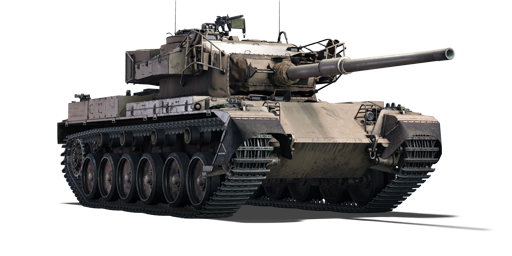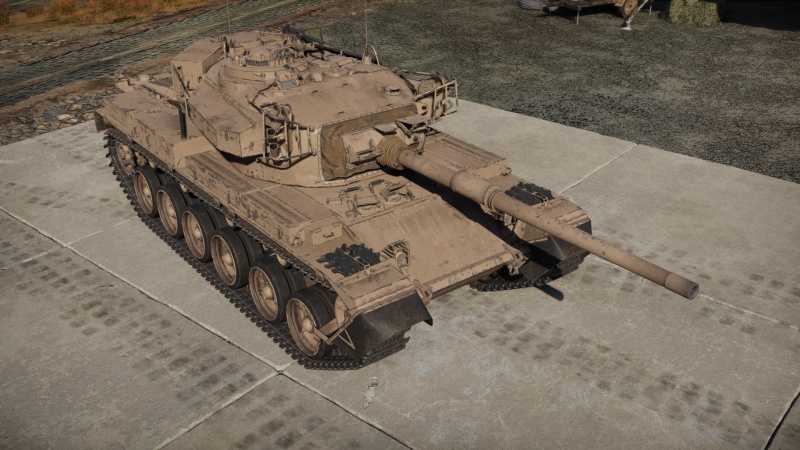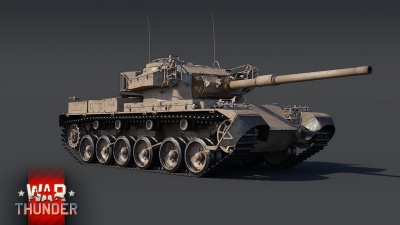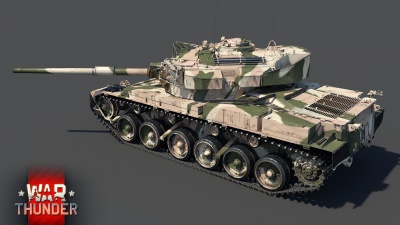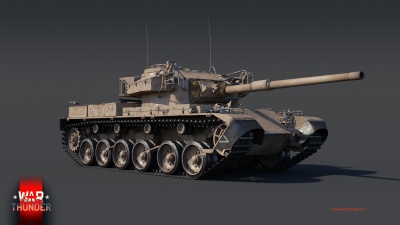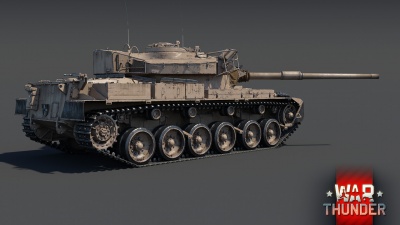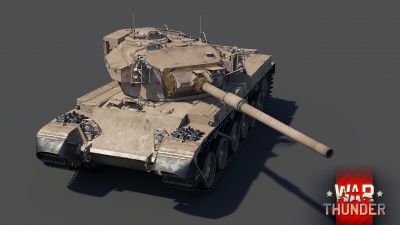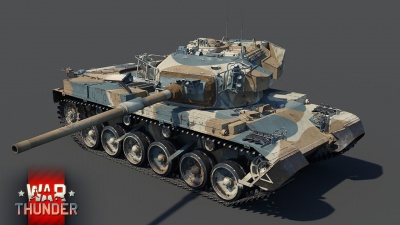Difference between revisions of "Olifant Mk.1A"
(→Pros and cons) |
CobraKingII (talk | contribs) (→History) (Tag: Visual edit) |
||
| Line 175: | Line 175: | ||
== History == | == History == | ||
<!-- ''Describe the history of the creation and combat usage of the vehicle in more detail than in the introduction. If the historical reference turns out to be too long, take it to a separate article, taking a link to the article about the vehicle and adding a block "/History" (example: <nowiki>https://wiki.warthunder.com/(Vehicle-name)/History</nowiki>) and add a link to it here using the <code>main</code> template. Be sure to reference text and sources by using <code><nowiki><ref></ref></nowiki></code>, as well as adding them at the end of the article with <code><nowiki><references /></nowiki></code>. This section may also include the vehicle's dev blog entry (if applicable) and the in-game encyclopedia description (under <code><nowiki>=== In-game description ===</nowiki></code>, also if applicable).'' --> | <!-- ''Describe the history of the creation and combat usage of the vehicle in more detail than in the introduction. If the historical reference turns out to be too long, take it to a separate article, taking a link to the article about the vehicle and adding a block "/History" (example: <nowiki>https://wiki.warthunder.com/(Vehicle-name)/History</nowiki>) and add a link to it here using the <code>main</code> template. Be sure to reference text and sources by using <code><nowiki><ref></ref></nowiki></code>, as well as adding them at the end of the article with <code><nowiki><references /></nowiki></code>. This section may also include the vehicle's dev blog entry (if applicable) and the in-game encyclopedia description (under <code><nowiki>=== In-game description ===</nowiki></code>, also if applicable).'' --> | ||
| + | === '''<big>Predecessor: Olifant Mk1</big>''' === | ||
| + | The Olifant Mk1 was a South African conversion of Centurion Mk3 tanks to a modified standard. Conversions began in 1979 and lasted until 1984; a total of 153 Olifant Mk1s were converted from Centurion Mk3s. Not long after the Olifant Mk1 entered production, T-55 tanks were obtained and tested which revealed flaws in the Olifant Mk1 in comparison. Fortunately for the SADF, an upgrade of the Olifant Mk1 was already under development. | ||
| + | |||
| + | === <big>'''Olifant Mk1A'''</big> === | ||
| + | The Olifant Mk1A was an upgrade for the Olifant Mk1 that began development in 1981. The main features were a new, fully stabilized 105 mm GT3B main gun, a new fire control system, and other improvements. | ||
| + | |||
| + | <big>'''Design'''</big> | ||
| + | |||
| + | '''General''' | ||
| + | |||
| + | The Olifant Mk1A has a crew of four, the driver in the hull and the commander, gunner, and loader in the turret. It maintains the base of the Centurion but with overhauls in most important aspects such as mobility and firepower. | ||
| + | |||
| + | '''Mobility''' | ||
| + | |||
| + | The Horstman suspension of the Centurion was retained on the Mk1A, having never been changed on the Olifant Mk1 or Mk1A. Propulsion was provided by a Continental 29 liter turbo charged air cooled radial V12 engine, which could produce 750 horsepower. In order to prevent the dust from the environment from interfering with the engine's operation, new dust filters were added. Additionally, a new rail system was implemented that allowed the engine to be replaced in only thirty minutes with a crane. A new transmission was fitted with two forward and one reverse gear. The Olifant Mk1A had a horsepower to ton ratio of 13.39 hp/t and could achieve a maximum speed of 45 kilometers per hour. | ||
| + | |||
| + | The fuel supply was increased from 458 liters to 1,240 liters, allowing the range of the Olifant Mk1A to increase to 350 kilometers at the maximum (the Centurion Mk 5 could only travel 190 km maximum). The reliability and ease of maintenance took precedence on the Olifant Mk1A, reducing the amount of maintenance that needed to be done overall. | ||
| + | |||
| + | '''Armament''' | ||
| + | |||
| + | The main armament of the Olifant Mk1A was a 105 mm L7 or GT3B rifled cannon, which was fully stabilized. The ammunition initially consisted of the L52A3 APDS, M456 HEAT and M156 HEAT rounds. In the mid-1980's, M111 APFSDS rounds were acquired for use on the Olifant Mk1A as the primary anti-tank ammunition. The ammunition stowage was redesigned an das such the total amount of 105 mm ammunition was increased from 64 to 72 rounds. | ||
| + | |||
| + | The turret rotation and gun elevation mechanisms were replaced with an improved electrical model. Also, the main gun was fully stabilized. A new fire control system (FCS) was fitted. The gunner's 6x zoom sight was replaced with an Eloptro 8x zoom sight which included a laser rangefinder. | ||
| + | |||
| + | Secondary armament consisted of a coaxial 7.62 mm machine gun and a pintle-mounted 7.62 mm machine gun on the commander's cupola. At least 5,600 rounds of 7.62 mm ammunition were provided. | ||
| + | |||
| + | '''Protection''' | ||
| + | |||
| + | The Olifant Mk1A retained the armour of the Centurion Mk 3. Needless to say, the Olifant Mk1A was incredibly vulnerable to the T-54/55 and T-62 tanks it would face in combat, and also to RPG-7 infantry anti-tank weapons. The Olifant Mk1A had two banks of four smoke grenades each mounted on each side of the turret for a total of eight launchers. | ||
| + | |||
=== [[wt:en/news/7052-development-olifant-mk1a-the-beast-of-desert-en|Devblog]] === | === [[wt:en/news/7052-development-olifant-mk1a-the-beast-of-desert-en|Devblog]] === | ||
Centurion tanks entered service with the South African armed forces already at the start of the Cold War in the early 1950s when South Africa purchased a few hundred Centurion Mk.3 tanks from the United Kingdom. However, operating the Centurions in the warm South African climate quickly turned out to be problematic as the tanks were prone to overheating. As a result, South Africa sold off many of its Centurions to Switzerland during the 1960s in order to acquire other equipment while many of the remaining tanks were relegated to reserve roles. | Centurion tanks entered service with the South African armed forces already at the start of the Cold War in the early 1950s when South Africa purchased a few hundred Centurion Mk.3 tanks from the United Kingdom. However, operating the Centurions in the warm South African climate quickly turned out to be problematic as the tanks were prone to overheating. As a result, South Africa sold off many of its Centurions to Switzerland during the 1960s in order to acquire other equipment while many of the remaining tanks were relegated to reserve roles. | ||
Revision as of 21:28, 24 March 2021
Contents
Description
The Olifant Mk.1A is a rank VI British medium tank with a battle rating of 8.3 (AB/RB/SB). It was introduced in Update "Ixwa Strike".
General info
Survivability and armour
Describe armour protection. Note the most well protected and key weak areas. Appreciate the layout of modules as well as the number and location of crew members. Is the level of armour protection sufficient, is the placement of modules helpful for survival in combat? If necessary use a visual template to indicate the most secure and weak zones of the armour.
Armour type:
| Armour | Front (Slope angle) | Sides | Rear | Roof |
|---|---|---|---|---|
| Hull | ___ mm | ___ mm Top ___ mm Bottom |
___ mm | ___ - ___ mm |
| Turret | ___ - ___ mm Turret front ___ mm Gun mantlet |
___ - ___ mm | ___ - ___ mm | ___ - ___ mm |
| Cupola | ___ mm | ___ mm | ___ mm | ___ mm |
Notes:
Mobility
| Game Mode | Max Speed (km/h) | Weight (tons) | Engine power (horsepower) | Power-to-weight ratio (hp/ton) | |||
|---|---|---|---|---|---|---|---|
| Forward | Reverse | Stock | Upgraded | Stock | Upgraded | ||
| Arcade | 53 | 10 | 56 | 1,162 | 1,431 | 20.75 | 25.55 |
| Realistic | 48 | 9 | 663 | 750 | 11.84 | 13.39 | |
Modifications and economy
Armaments
Main armament
| 105 mm GT-3 | Turret rotation speed (°/s) | Reloading rate (seconds) | |||||||||||
|---|---|---|---|---|---|---|---|---|---|---|---|---|---|
| Mode | Capacity | Vertical | Horizontal | Stabilizer | Stock | Upgraded | Full | Expert | Aced | Stock | Full | Expert | Aced |
| Arcade | 72 | -10°/+20° | ±180° | Two-plane | 11.4 | 15.8 | 19.2 | 21.2 | 22.6 | 8.71 | 7.70 | 7.10 | 6.70 |
| Realistic | 7.1 | 8.4 | 10.2 | 11.3 | 12.0 | ||||||||
Ammunition
| Penetration statistics | |||||||
|---|---|---|---|---|---|---|---|
| Ammunition | Type of warhead |
Penetration @ 0° Angle of Attack (mm) | |||||
| 10 m | 100 m | 500 m | 1,000 m | 1,500 m | 2,000 m | ||
| M152 | HEATFS | 400 | 400 | 400 | 400 | 400 | 400 |
| M156 | HESH | 127 | 127 | 127 | 127 | 127 | 127 |
| M111 | APFSDS | 337 | 335 | 330 | 322 | 314 | 306 |
| Shell details | |||||||||
|---|---|---|---|---|---|---|---|---|---|
| Ammunition | Type of warhead |
Velocity (m/s) |
Projectile Mass (kg) |
Fuse delay (m) |
Fuse sensitivity (mm) |
Explosive Mass (TNT equivalent) (g) |
Ricochet | ||
| 0% | 50% | 100% | |||||||
| M152 | HEATFS | 1,173 | 10.5 | 0.05 | 0.1 | 1,270 | 65° | 72° | 77° |
| M156 | HESH | 732 | 14.85 | 0.05 | 0.1 | 4,310 | 73° | 77° | 80° |
| M111 | APFSDS | 1,455 | 3.79 | N/A | N/A | N/A | 78° | 80° | 81° |
| Smoke shell characteristics | ||||||
|---|---|---|---|---|---|---|
| Ammunition | Velocity (m/s) |
Projectile Mass (kg) |
Screen radius (m) |
Screen deploy time (s) |
Screen hold time (s) |
Explosive Mass (TNT equivalent) (g) |
| M416 | 730 | 11.4 | 20 | 5 | 25 | 50 |
Ammo racks
| Full ammo |
1st rack empty |
2nd rack empty |
3rd rack empty |
4th rack empty |
5th rack empty |
6th rack empty |
Visual discrepancy |
|---|---|---|---|---|---|---|---|
| 72 | __ (+__) | __ (+__) | __ (+__) | __ (+__) | __ (+__) | __ (+__) | __ |
Machine guns
| 7.62 mm L3A1 | ||||
|---|---|---|---|---|
| Mount | Capacity (Belt) | Fire rate | Vertical | Horizontal |
| Coaxial | 3,000 (250) | 500 | N/A | N/A |
Usage in battles
Describe the tactics of playing in the vehicle, the features of using vehicles in the team and advice on tactics. Refrain from creating a "guide" - do not impose a single point of view but instead give the reader food for thought. Describe the most dangerous enemies and give recommendations on fighting them. If necessary, note the specifics of the game in different modes (AB, RB, SB).
Pros and cons
Pros:
- Strong APFSDS
- Laser rangefinder for long range operations
- Excellent gun elevation and depression angles (-10°, +20°)
- Enough armour to resist autocannons and some poorly aimed shots
Cons:
- Very poor turret traverse making reactionary shooting hard without moving the hull
- Poor mobility and top speed compared to other MBTs at the BR
- APFSDS is a tier 4 modification
- Armour is very unreliable at stopping any APFSDS or HEAT rounds even from small calibre guns
- Ammo rack is in the front of the vehicle to the right of the driver and is a major weak spot
History
Predecessor: Olifant Mk1
The Olifant Mk1 was a South African conversion of Centurion Mk3 tanks to a modified standard. Conversions began in 1979 and lasted until 1984; a total of 153 Olifant Mk1s were converted from Centurion Mk3s. Not long after the Olifant Mk1 entered production, T-55 tanks were obtained and tested which revealed flaws in the Olifant Mk1 in comparison. Fortunately for the SADF, an upgrade of the Olifant Mk1 was already under development.
Olifant Mk1A
The Olifant Mk1A was an upgrade for the Olifant Mk1 that began development in 1981. The main features were a new, fully stabilized 105 mm GT3B main gun, a new fire control system, and other improvements.
Design
General
The Olifant Mk1A has a crew of four, the driver in the hull and the commander, gunner, and loader in the turret. It maintains the base of the Centurion but with overhauls in most important aspects such as mobility and firepower.
Mobility
The Horstman suspension of the Centurion was retained on the Mk1A, having never been changed on the Olifant Mk1 or Mk1A. Propulsion was provided by a Continental 29 liter turbo charged air cooled radial V12 engine, which could produce 750 horsepower. In order to prevent the dust from the environment from interfering with the engine's operation, new dust filters were added. Additionally, a new rail system was implemented that allowed the engine to be replaced in only thirty minutes with a crane. A new transmission was fitted with two forward and one reverse gear. The Olifant Mk1A had a horsepower to ton ratio of 13.39 hp/t and could achieve a maximum speed of 45 kilometers per hour.
The fuel supply was increased from 458 liters to 1,240 liters, allowing the range of the Olifant Mk1A to increase to 350 kilometers at the maximum (the Centurion Mk 5 could only travel 190 km maximum). The reliability and ease of maintenance took precedence on the Olifant Mk1A, reducing the amount of maintenance that needed to be done overall.
Armament
The main armament of the Olifant Mk1A was a 105 mm L7 or GT3B rifled cannon, which was fully stabilized. The ammunition initially consisted of the L52A3 APDS, M456 HEAT and M156 HEAT rounds. In the mid-1980's, M111 APFSDS rounds were acquired for use on the Olifant Mk1A as the primary anti-tank ammunition. The ammunition stowage was redesigned an das such the total amount of 105 mm ammunition was increased from 64 to 72 rounds.
The turret rotation and gun elevation mechanisms were replaced with an improved electrical model. Also, the main gun was fully stabilized. A new fire control system (FCS) was fitted. The gunner's 6x zoom sight was replaced with an Eloptro 8x zoom sight which included a laser rangefinder.
Secondary armament consisted of a coaxial 7.62 mm machine gun and a pintle-mounted 7.62 mm machine gun on the commander's cupola. At least 5,600 rounds of 7.62 mm ammunition were provided.
Protection
The Olifant Mk1A retained the armour of the Centurion Mk 3. Needless to say, the Olifant Mk1A was incredibly vulnerable to the T-54/55 and T-62 tanks it would face in combat, and also to RPG-7 infantry anti-tank weapons. The Olifant Mk1A had two banks of four smoke grenades each mounted on each side of the turret for a total of eight launchers.
Devblog
Centurion tanks entered service with the South African armed forces already at the start of the Cold War in the early 1950s when South Africa purchased a few hundred Centurion Mk.3 tanks from the United Kingdom. However, operating the Centurions in the warm South African climate quickly turned out to be problematic as the tanks were prone to overheating. As a result, South Africa sold off many of its Centurions to Switzerland during the 1960s in order to acquire other equipment while many of the remaining tanks were relegated to reserve roles.
With conflicts in the region flaring up during the '70s, the South African armed forces were reminded of the importance of their armored units and several projects were initiated to modernize the Centurions in service. These projects resulted in the creation of two interim models of domestic Centurions - the Skoikaan and Semel. In parallel however, the South African government formed a company in the private sector to develop a proper modernization package for the Centurion.
Work on the project began in the mid '70s, with South African engineers taking inspiration from the Israeli Sho't Centurions and applying similar upgrades to what would eventually become known as the Olifant tank. The first prototype of the Olifant rolled out of the factory in 1976 and underwent testing. Shortly afterwards, the Olifant Mk1 entered production service in 1978, with production lasting until 1984. In the early 80s, the Olifant was upgraded to the Mk.1A modification, which featured a domestic version of the L7 cannon as well as other upgrades.
The Olifant Mk1A remained in service with SANDF into the 1990s before being succeeded by the Olifant Mk 2. In total, over 150 Olifant Mk1As were produced, some seeing action during the conflicts with Angola in the early 1980s.
Media
See also
Links to the articles on the War Thunder Wiki that you think will be useful for the reader, for example:
- reference to the series of the vehicles;
- links to approximate analogues of other nations and research trees.
External links
Paste links to sources and external resources, such as:
- topic on the official game forum;
- other literature.
| Britain medium tanks | |
|---|---|
| Valentine | Valentine I · Valentine IX · Valentine XI |
| Cromwell | Cromwell I · Cromwell V · Cromwell V (RP-3) |
| Cromwell derivatives | Challenger · Avenger · Comet I · Comet I "Iron Duke IV" · Charioteer Mk VII |
| Centurion | Centurion Mk 1 · Centurion Mk.2 · Centurion Mk 3 · Centurion Mk.5 AVRE · Centurion Mk 10 · Centurion Action X · FV4202 |
| Vickers MBT | Vickers Mk.1 · Vickers Mk.3 · Vickers Mk.7 |
| Chieftain | Chieftain Mk 3 · Chieftain Mk 5 · Chieftain Mk 10 |
| Challenger 1 | Challenger Mk.2 · Challenger Mk.3 · Challenger DS |
| Challenger 2 | Challenger 2 · Challenger 2 (2F) · Challenger 2 TES · Challenger 2 OES · Challenger 2E · Challenger 2 Black Night |
| Challenger 3 | Challenger 3 TD |
| Australia | A.C.I · A.C.IV · Centurion Mk.5/1 |
| South Africa | Olifant Mk.1A · Olifant Mk.2 · TTD |
| India | Vijayanta · Bhishma TWMP |
| Israel | ▄Sho't Kal Dalet |
| Jordan | Khalid |
| Sweden | ▄Strv 81 (RB 52) |
| USA | Grant I · Sherman II · Sherman Firefly · Sherman IC "Trzyniec" |


